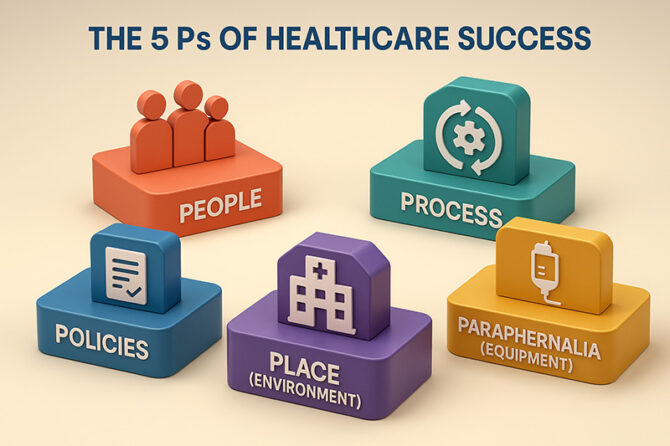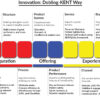
Healthcare is, arguably, the world’s most complex industry,—where lives of people, technology, and organizational vision meet. Hospitals and healthcare organizations are unable to act like other organizations, seeking to only maximize profits; rather, they must consider clinical excellence versus ethical accountability. The success of each healthcare organization lies with five pillars, or what I term as 5 Ps: People, Process, Paraphernalia, Place, and Policies.
These are not mutually isolated factors; they are interconnected determinants of patient outcomes, brand reputation, and financial sustainability. Let us examine each P in practice closely, by drawing lessons both from international and Indian experiences.
1. People – The Beat of Healthcare
The finest new hospital infrastructure is of minimal use without appropriate people. The doctors, nurses, allied health professionals, technicians, and administrators are the face of care. The skills, empathy, and commitment of them build the patient experience.
In India, institutions like AIIMS (New Delhi) and Apollo Hospitals have made a name primarily because of successful attraction, development, and retention of world-class talents. Globally, Mayo Clinic in the USA has been called the gold standard of people-based care, in which interdisciplinary care gives whole-person care.
“Medicine is a science of uncertainty and an art of probability.” – William Osler
Training and continuing professional development are a must. For instance, Bengaluru-based Narayana Health has adopted Dr. Devi Shetty’s “low-cost, high-volume” approach to care, but it works only because of well-trained, mission-driven staff.
Business Lesson: Invest in people, not only employees, but as long-term partners in the mission. Systematic instruction, competitive compensation, and appreciation systems build motivated teams that drive patient loyalty.
2. Process – Transforming Complexity into Clarity
Healthcare processes are intrinsically complicated, encompassing diagnosis, treatment options, insurance protocols, and discharge protocols. A good organization simplifies such complications into simple, easy-to-comprehend systems among patients.
Consider Tata Memorial in Mumbai, whose oncologic care transcends multiple disciplines. Their centralized “tumour board” protocol insures that patients get multidisciplinary input under one roof promptly and without confusion. Internationally, Cleveland Clinic excels in streamlining care protocols across its facilities, thereby reducing variability in results.
“Quality is never an accident; it is always the result of intelligent effort.” – John Ruskin
The digitization has been a game-changer in enhancing process efficiency. Launch of India’s Ayushman Bharat Digital Mission (ABDM) is a path-breaking initiative to digitalize health care records, discouraging flow of patient data among hospitals. Similarly, the UK’s NHS introduced electronic health records (EHRs) to discourage duplication while improving continuity of care.
Business Learning: Standardize without sacrificing personalization. The concept of Lean Six Sigma and Kaizen, if applied in medicine, can reduce costs and error while improving patient experience.
3. Paraphernalia (Equipment) – Tools that Empower Care
In medicine, equipment is not luxury, it is a necessity. Paraphernalia, from MRI scanners to robotic surgery systems, enhances diagnostic precision and therapeutic exactitude. But equipment must be in harmony with organizational objectives and population demographics.
For example, Aravind Eye Care System revolutionized cataract surgery by adopting cost-efficient, world-class technology, enabling them to perform millions of operations at affordable costs. In Johns Hopkins Hospital around the world, state-of-the-art robots are used to aid minimally invasive surgery, shortening recovery periods.
“The great thing in the world is not so much where we stand, as in what direction we are moving.” – Oliver Wendell Holmes But that does not mean equipment must be extravagant. The great majority of district hospitals in India are saddled with “white elephants”—machines bought without maintenance funds or operators. Clever spending means choosing scalable, sustainable paraphernalia that satisfies both clinical and financial imperatives.
Business Instruction: Buy equipment, not status, but purpose. Educate staff, maintenance budget, and take into consideration patient affordability in purchasing.
4. Place (Environment) – Healing Beyond Medicine
Physical and emotional environments of a medical building influence recovery to a great extent. Research finds that exposure to natural lighting, vegetation, and sound control lowers stress as well as facilitates speedy recovery.
Hospitals like Fortis Healthcare in India invested heavily in patient-centric design, like spacious, ventilated ICUs to lively paediatric wards. Globally, Singapore General embeds art and gardens in design, providing a therapeutic space.
“The environment shapes people far more than people shape the environment.” – Richard Neutra
Even cleanliness, too-often overlooked, is of utmost importance. India’s NABH (National Accreditation Board for Hospitals) necessitates strict infection control protocols—sanitation that patients themselves so frequently equate with quality. The underfunded government hospitals, on the other hand, often grapple with overcrowding, testifying to how environs impact perception.
Business Takeaway: Treat place as therapy. From reception to recovery rooms, environments should build confidence, reduce anxiety, and create trust.
5. Policies – The Invisible Hand of Governance
Policies are what underpin organizational culture and accountability. They include clinical protocols, HR rules, price strategies, insurance tie-ups, and ethical guidelines.
In India, Manipal Hospitals introduced price-transparency policies and standard treatment guidelines that help in building confidence among patients. Internationally, Kaiser Permanente (USA) is one such policy-driven integrated care, wherein preventive health is promoted as a cost-minimization strategy over a long term.
“Transparency and accountability in healthcare aren’t choices; they’re responsibilities.” – Atul Gawande
Policies should also be inclusive and accessible. The scheme of Ayushman Bharat has brought healthcare access to millions of Indians, but hospitals should link internal policies in order to translate such schemes into real action.
Business Takeaway: proper policies protect both providers and patients. They create predictability, prevent conflicts, and also ensure long-term sustainability.
Incorporating the 5 Ps – The Healthcare Success Flywheel
The real magic happens when all 5 Ps work in tandem. Take Apollo Hospitals, which balances brilliant people, efficient processes, up-to-date paraphernalia, patient-centric environments, and firm policies—and becomes a brand of confidence in India as well as abroad. In general, this Mayo Clinic model shows us how such pillar coordination begets a culture of excellence.
Healthcare leaders should consider these Ps not as checklist items, but as symbiotic gears in a flywheel. When each of them gets made stronger, momentum accumulates—and the organization improves, becoming good, then great.
Final thoughts
The accomplishment of a healthcare organization is not a one-time achievement but a sustainment. Human being provides the beat, processes keep cadence, paraphernalia provides power of precision, place makes curing happen, and policies sustain confidence.
The 5 Ps model, in total, provides us with a worldwide template of excellence in healthcare. In the words of Mahatma Gandhi, “It is health that is real wealth and not pieces of gold and silver.” Wealth is not merely monetary gains to healthcare organizations, but also trust, cures, and influence that arise out of them in society.
Dr. Prahlada N.B
MBBS (JJMMC), MS (PGIMER, Chandigarh).
MBA in Healthcare & Hospital Management (BITS, Pilani),
Postgraduate Certificate in Technology Leadership and Innovation (MIT, USA)
Executive Programme in Strategic Management (IIM, Lucknow)
Senior Management Programme in Healthcare Management (IIM, Kozhikode)
Advanced Certificate in AI for Digital Health and Imaging Program (IISc, Bengaluru).
Senior Professor and former Head,
Department of ENT-Head & Neck Surgery, Skull Base Surgery, Cochlear Implant Surgery.
Basaveshwara Medical College & Hospital, Chitradurga, Karnataka, India.
My Vision: I don’t want to be a genius. I want to be a person with a bundle of experience.
My Mission: Help others achieve their life’s objectives in my presence or absence!
My Values: Creating value for others.
Leave a reply
















Dear Dr. Prahlada N.B Sir,
Your insightful article on the 5 Ps of Healthcare Success – People, Process, Paraphernalia, Place, and Policies – highlights the essential elements for a thriving healthcare system. These pillars indeed work in tandem to ensure patient-centric care, operational efficiency, and sustainable growth.
*The Original 5 Ps:*
– *People*: The heartbeat of healthcare, where skilled professionals deliver compassionate care.
– *Process*: Streamlined workflows that simplify complexity and enhance patient experience.
– *Paraphernalia*: State-of-the-art equipment that empowers precise diagnosis and treatment.
– *Place*: Healing environments that promote recovery and comfort.
– *Policies*: Governance frameworks that ensure accountability, transparency, and quality care.
*Additional Ps to Consider:*
– *Partnerships*: Collaborations with stakeholders, including patients, families, and community organizations, to foster holistic care.
– *Precision*: Personalized medicine approaches that tailor treatments to individual needs.
– *Prevention*: Proactive strategies to promote health, wellness, and disease prevention.
– *Patient Engagement*: Empowering patients to take an active role in their care through education, support, and involvement.
– *Performance Measurement*: Continuous monitoring and evaluation of healthcare outcomes to drive improvement.
*The Interplay:*
When these Ps work together in harmony, they create a symphony of excellence in healthcare. By prioritizing people, processes, and policies, healthcare organizations can deliver high-quality, patient-centered care that improves outcomes and satisfaction.
Thank you for sharing your expertise, Dr. Prahlada N.B Sir. Your work inspires healthcare leaders to strive for excellence and create a better future for patients and communities.
With appreciation and respect.
Reply